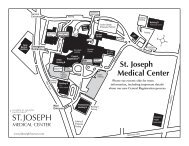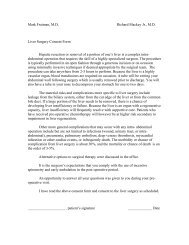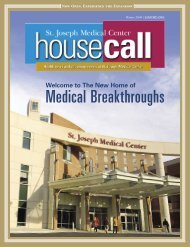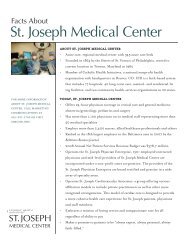Whipple Procedure Consent Form
Whipple Procedure Consent Form
Whipple Procedure Consent Form
You also want an ePaper? Increase the reach of your titles
YUMPU automatically turns print PDFs into web optimized ePapers that Google loves.
Mark Fraiman, M.D.<br />
Richard Mackey Jr., M.D.<br />
Pancreatic Surgery <strong>Consent</strong> <strong>Form</strong><br />
The whipple procedure is a complex intra-abdominal operation that requires the<br />
expertise of a specialty-trained hepato-biliary and pancreatic surgeon. The operation<br />
involves removal of the head of the pancreas, gallbladder, and duodenum. The<br />
reconstruction involves creating a new communication between the stomach, bile duct<br />
and pancreas. The procedure typically takes 3-5 hours to perform. Occasionally a portion<br />
of the superior mesenteric vein or portal vein may need to be removed with the specimen.<br />
If this occurs, you will also have an incision in your leg to harvest a portion of either your<br />
saphenous or superficial femoral vein to repair the portal vein.<br />
After surgery you will have two tubes in your nose, one to decompress your<br />
stomach and one to feed you. You will also have a drain exiting your abdominal wall.<br />
The majority of times, all tubes will be removed prior to discharge.<br />
The more common material risks and complications related to the whipple<br />
procedure are leakage from the pancreaticobiliary anastomosis (15%) or delayed gastric<br />
emptying (30%). Some patients may experience either one or both of these complications<br />
that do not resolve prior to your discharge. In these situations, you may be discharged<br />
from the hospital with the tube in your side as well as the tube in your nose for a period<br />
of 4 to 6 weeks. If you are having a distal pancreatectomy, there is no gastric or biliary<br />
anastomosis, however the incidence of pancreatic fistula and delayed gastric emptying<br />
are similar to that of the whipple procedure.<br />
Other more general complications that may occur with any intra-abdominal<br />
operation include but are not limited to infections (wound, urinary tract or intraabdominal),<br />
pneumonia, pulmonary embolism, deep venous thrombosis, myocardial<br />
infarction, or other cardiac events or very infrequently death. The morbidity or chance or<br />
having any complication from the whipple procedure is as high as 40% and the mortality<br />
or chance of death from the procedure is around 2%.<br />
Alternative options to surgical treatment were discussed in the office.<br />
It is the surgeon’s expectations that you comply with the use of incentive<br />
spirometry and early ambulation in the post-operative period.<br />
An opportunity to answer all your questions was given to you during your preoperative<br />
office visit.<br />
I have read the above consent form and consent to the pancreatic surgery as<br />
scheduled.
_______________________ patient’s signature __________ date<br />
________________________ witness’ signature<br />
__________ date<br />
________________________ surgeon’s signature<br />
___________ date
















